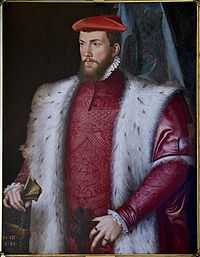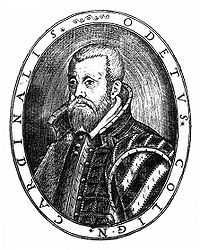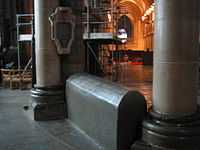Odet de Coligny
| Odet de Coligny | |
|---|---|
| Cardinal, Bishop of Beauvais | |
 | |
| Church | Roman Catholic, later Calvinist |
| See | Beauvais |
| In office | 1535–63 |
| Personal details | |
| Born |
10 July 1517 Châtillon-Coligny |
| Died |
14 February 1571 (aged 53) Canterbury, Kent, England |
| Previous post | Bishop and Cardinal |
Odet de Coligny (10 July 1517 – 14 February 1571) was a French cardinal of Châtillon, bishop of Beauvais, son of Gaspard I de Coligny and Louise de Montmorency, and brother of Gaspard and François, Seigneur d'Andelot.
Life
Birth
His birth at Châtillon-Coligny, as his parents' second son, was recorded in his mother's book of hours.[1]
Catholic career
He occupied high church offices during this initial part of his career. He became prior of Saint-Stephan in Beaume in 1530. At the papal consistory of 7 November 1533 (at 16 and whilst still a layman)[2] he was created cardinal deacon, receiving the red hat and the titular church of Santi Sergio e Bacco three days later. Soon afterwards he became Abbot of Saint Bénigne de Dijon, of Fleury, of Ferrière and of Vaux de Cernay. In 1534 he became a Canon in Paris, participated in a papal conclave, and was made administrator of the metropolitan see of Toulouse on 29 April, despite not yet having been ordained a priest. This he held until his resignation from that role on 20 October 1550. Meanwhile, on 20 October 1535, he had become administrator of the see of Beauvais, and Abbot of Saint-Lucien de Beauvais from 1537.
He opted for the deaconry of S. Adriano on 25 February 1549 and participated in the papal conclave of 1549–50. He was placed in charge of the library of France's Royal Privy Council and, using this and his other offices, he protected his friends Ronsard and Rabelais, in 1550 obtaining for the latter a ten year monopoly on book-printing – Rabelais dedicated his Quart Livre to Odet in gratitude.
In 1556 he became abbot of Ferrières on the recommendation of Pope Pius IV and Henry II, and four years later, Pius named him grand inquisitor of France, though the French parliament's opposition to the inquisition prevented him taking up the post. Sometime after 1560 he also became abbot of Grandchamps, of Quincy and (from 1560) of Vézelay. In sum, then, he was Abbot of St. Euvertius, of Fontainejean, Ferrières, and St. Benoît, and from 1554 to 1560 prior (and after 1560 provost) of St-Pierre de Mâcon.
Protestant career




However, under his family's influence, he eventually went over to the Protestant camp himself, becoming a Calvinist Huguenot in April 1561. Indeed, some said it to be little surprise since his long church career was more motivated by ambition than piety,[3] though he was not the only French prelate to convert to Calvinism in this period – one other example is Jean de Monluc, bishop of Valence. Gathering a faction around himself, he greatly helped those of the Huguenot party. He participated with his brother in the religious wars and acted as a mediator between the Protestants and Queen Catherine de' Medici.
In 1562, he escaped the Inquisition to Lyon, relinquished his title of cardinal and called himself the count of Beauvais (comte de Beauvais), after his old bishopric. In the secret consistory of 31 March 1563, Pope Pius IV and the French parliament excommunicated him as a heretic and deprived him of all his offices. In December 1564, he married his mistress Isabeau/Isabelle de Hauteville (also known as Elizabeth de Kanteville or Mme. la Cardinale) at Montataire, without a Catholic ceremony[4] and wearing, at the Huguenots' request, his cardinal's robe.
He fought at the Battle of Saint-Denis and in 1568 fled to England. In London, he requested monetary support for the French Protestants from Queen Elizabeth, who favoured him and his wife. Still wanted by the French government for treason, he remained in England, probably because he had secret orders from the French court to seek Elizabeth's hand in marriage for the prince of Anjou.
In 1568, his former abbacy of Ferrières was besieged by the troops of Louis de Condé, friend of the Coligny family and fellow Protestant. The abbey was pillaged and profaned and, although no monks were killed, the reliquaires and treasures of the abbey were dispersed, the tombs of Louis III, Carloman and Louis de Blanchefort[5] heavily damaged and the monks' stalls removed. Odet (abroad by then) intervened to stop this only after three days, when his own financial interests in the benefice seemed threatened.
Death
He was preparing to go from England to La Rochelle to join his brother when he died at the former pilgrims' lodge at Canterbury under mysterious circumstances (possibly poisoned by his servant, perhaps on the orders of the French government) in 1571.
He was therefore buried in a temporary and very plain tomb covered in hessian and plaster in the Trinity Chapel in the east end of Canterbury Cathedral. It was meant to have been a temporary solution pending his body's return to France, but it never occurred, and he still rests there.
One conspiracy theory relates that since Coligny not being high-ranking enough for permanent burial in this important part of the cathedral, the tomb in fact contains the hidden relics of Thomas Becket from his nearby shrine (dissolved 40 years earlier), Coligny's body having been returned to France or never in fact laid to rest here. This theory is not, however, accepted by historians.
Family tree
| Coligny family tree | |||||||||||||||||||||||||||||||||||||||||||||||||||||||||||||||||||||||||||||||||||||||||||||||||||||||||||||||||||||||||||||||||||||||||||||||||||||||||||||||||||||||||||||||||||||||||||||||||||||||||||||||||||||||||||||||||||||||||||||||||||||||||||||||||||||||||||||||||||
|---|---|---|---|---|---|---|---|---|---|---|---|---|---|---|---|---|---|---|---|---|---|---|---|---|---|---|---|---|---|---|---|---|---|---|---|---|---|---|---|---|---|---|---|---|---|---|---|---|---|---|---|---|---|---|---|---|---|---|---|---|---|---|---|---|---|---|---|---|---|---|---|---|---|---|---|---|---|---|---|---|---|---|---|---|---|---|---|---|---|---|---|---|---|---|---|---|---|---|---|---|---|---|---|---|---|---|---|---|---|---|---|---|---|---|---|---|---|---|---|---|---|---|---|---|---|---|---|---|---|---|---|---|---|---|---|---|---|---|---|---|---|---|---|---|---|---|---|---|---|---|---|---|---|---|---|---|---|---|---|---|---|---|---|---|---|---|---|---|---|---|---|---|---|---|---|---|---|---|---|---|---|---|---|---|---|---|---|---|---|---|---|---|---|---|---|---|---|---|---|---|---|---|---|---|---|---|---|---|---|---|---|---|---|---|---|---|---|---|---|---|---|---|---|---|---|---|---|---|---|---|---|---|---|---|---|---|---|---|---|---|---|---|---|---|---|---|---|---|---|---|---|---|---|---|---|---|---|---|---|---|---|---|---|---|---|---|---|---|---|---|---|---|---|---|---|
| |||||||||||||||||||||||||||||||||||||||||||||||||||||||||||||||||||||||||||||||||||||||||||||||||||||||||||||||||||||||||||||||||||||||||||||||||||||||||||||||||||||||||||||||||||||||||||||||||||||||||||||||||||||||||||||||||||||||||||||||||||||||||||||||||||||||||||||||||||
| Notes:
| |||||||||||||||||||||||||||||||||||||||||||||||||||||||||||||||||||||||||||||||||||||||||||||||||||||||||||||||||||||||||||||||||||||||||||||||||||||||||||||||||||||||||||||||||||||||||||||||||||||||||||||||||||||||||||||||||||||||||||||||||||||||||||||||||||||||||||||||||||
Sources
- ↑ "10 juillet 1517", Journal du seizième siècle [Journal of the XVI Century] (in French), FR: Free.
- ↑ "Consistory of 7 November 1533", The Cardinals of the Holy Roman Church (biographical dictionary), FIU.
- ↑ Abb ferr 2 (in French), FR: Orange .
- ↑ "College", Établissements [Institutions] (in French), FR: AC Amiens.
- ↑ "Richesses", Œuvres [Works] (in French), Patrimoine de France.
Bibliography
- Atkinson, Ernest G (1890), The Cardinal of Châtillon in England, 1568–1571 : a paper read on 13 November 1889, before the Huguenot society of London, London: Spottiswoode & co.
- Becquerel, Antoine César (1876), Souvenirs historiques sur l'amiral Coligny : sa famille et sa seigneurie de Châtillon-Sur-Loing [Historical memories on the Admiral Coligny: his family and his Châtillon‐sur‐Loing mansard] (in French) (2d ed.), Paris: Firmin-Didot.
- Berton, Charles (1857), Dictionnaire des cardinaux, contenant des notions générales sur le cardinalat, la nomenclature complète..., des cardinaux de tous les temps et de tous les pays... les détails biographiques essentiels sur tous les cardinaux... de longues études sur les cardinaux célèbre... [Dictionary of Cardinals, containing general notions on the cardinalship, the complete nomeclature… the Cardinals from all time and countries… the essential biographic details on all Cardinals… long studies on the famous Cardinals…] (in French), Paris: J.-P. Migne; facsimile edition. Farnborough.
- Cardella, Lorenzo (1969) [1793], Gregg, ed., Memorie storiche de' cardinali della Santa Romana Chiesa [Historical memory of the Cardinals of the Holy Roman Church] IV, Rome: Stamperia Pagliarini, pp. 134–35 cols 692–93.
- Chacón, Alfonso (1630), Vitæ, et res gestæ Pontificvm Romanorum et S. R. E. Cardinalivm ab initio nascentis Ecclesiæ vsque ad Vrbanvm VIII. Pont. Max [Life, and the exploits of the Priests of the Romans and of Sacred R. E. Cardinals from the very beginning of the Church until Vrbanvm 8. Pont. Max.] (in Latin) II, Roma: Typis Vaticanis, cols. 1480–81, 2 volumes.
- Coligny, Odet de, cardinal de Chatillon, 1515–71 (1885), Marlet, M. Léon, ed., Correspondence d'Odet de Coligny, cardinal de Chatillon (1537–1568) [Correspondence of Odet de Coligny, Cardinal of Châtillon (1537–68)] (in French), Paris: A Picard (Documents publ. par la Societé historique & archéologique du Gatinais; I).
- Eubel, Guglielmus van; Gulik (1935), Hierarchia Catholica Medii et Recientoris Aevi [The Catholic hierarchy mediæval & recent] (in Latin), Münich: Sumptibus et Typis Librariae Regensbergianae
.
- Il Messaggero di S. Antonio III (reprint ed.), Padua, 1960, pp. 22, 72, 76, 131, 315.
- Marlet, Léon (1883), Le Cardinal de Châtillon : 1517–1571, Paris: H Menu.
External links
- Schaff, Biography, CCEL.
- Article, and image of his tomb
- Biography, FIU.
- Coligny (biography) (in French).
- Another biography
- An image of him as Neptune
|